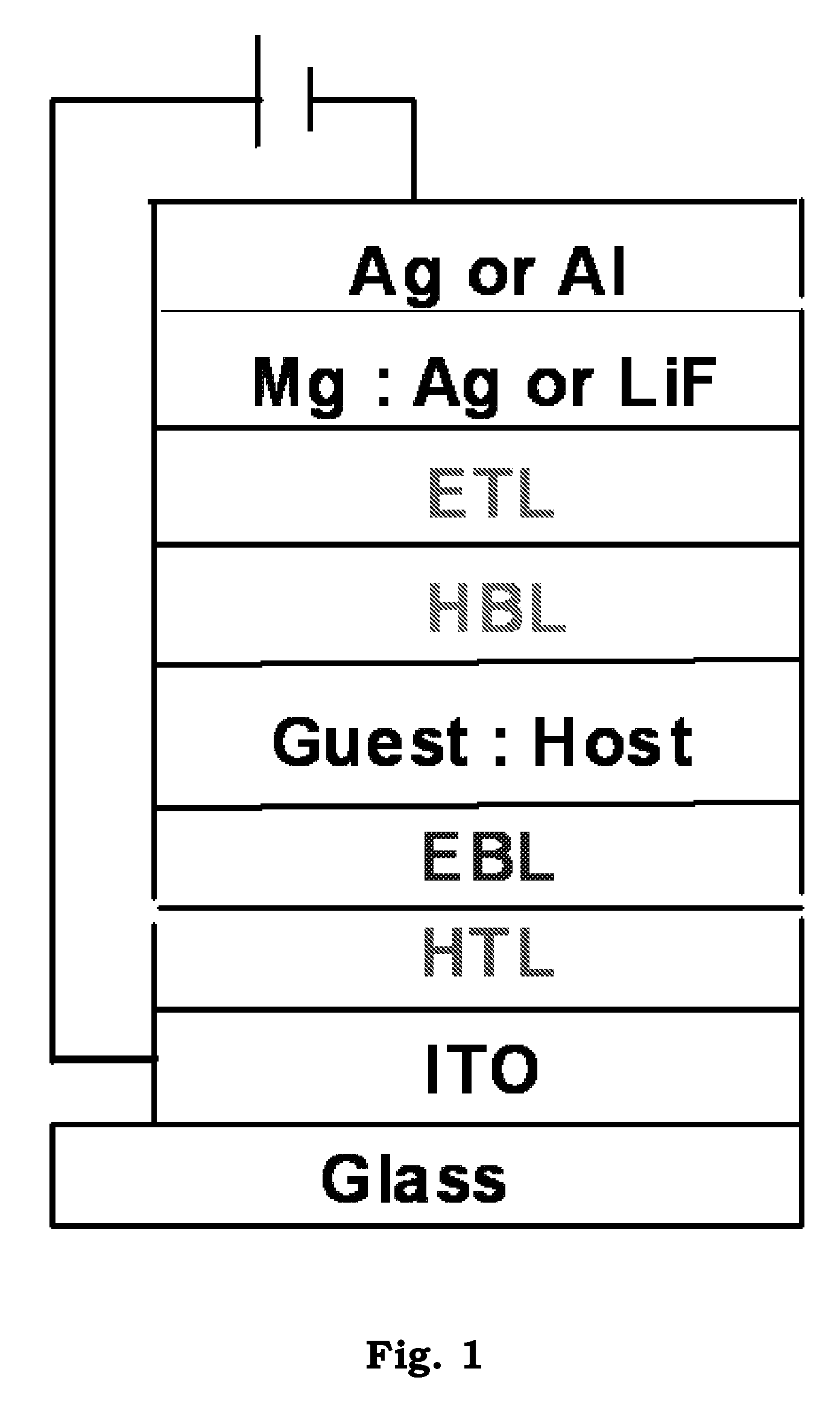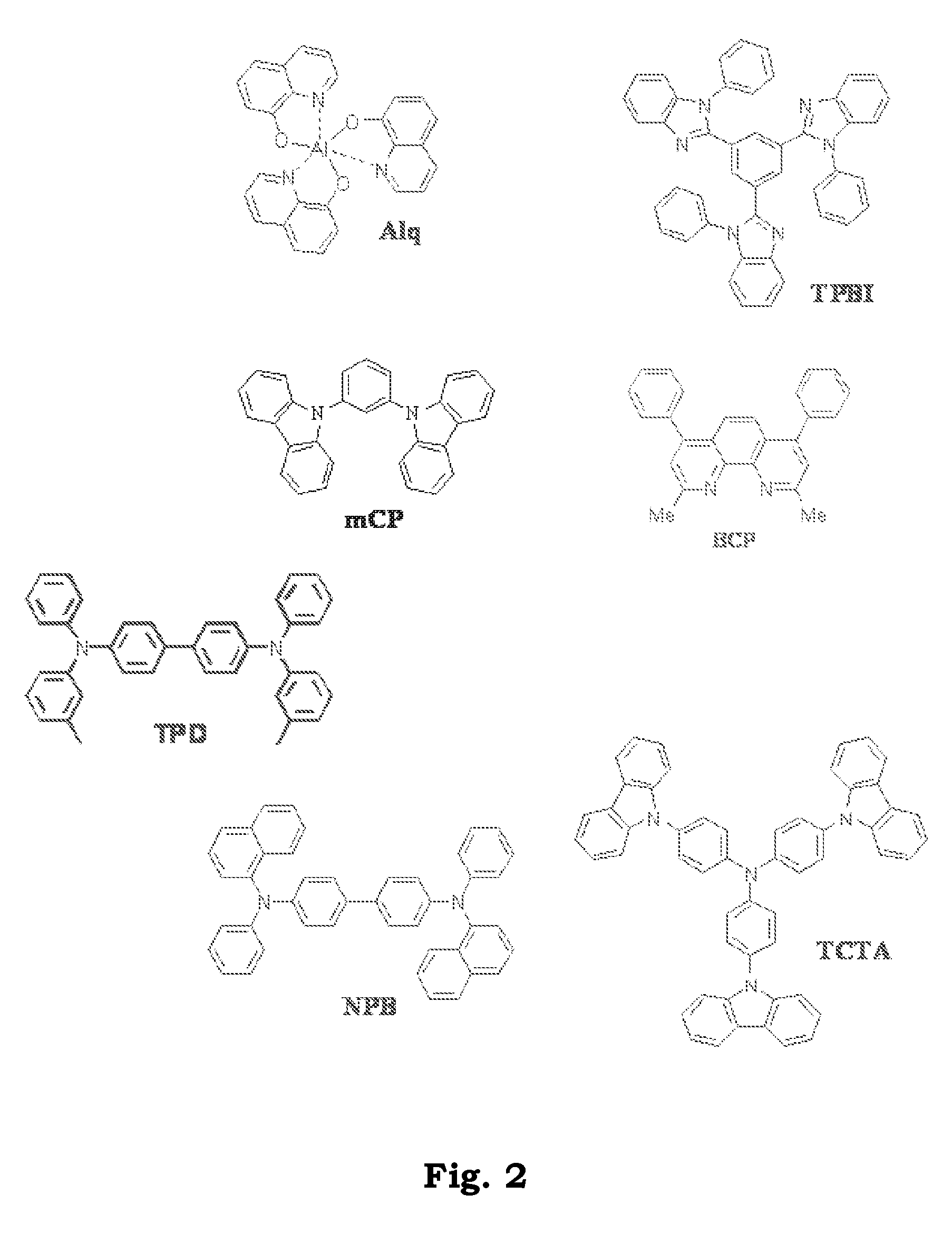Transition metal complexes with carbene ligands and their application
a technology of carbene ligands and transition metal complexes, which is applied in the direction of indium organic compounds, discharge tubes luminescnet screens, other domestic articles, etc., can solve the problems of poor color saturation and not all heavy atoms are suitable for this purpose, and achieve high triplet energy level, prolong the life of application organic devices, and high thermal stability
- Summary
- Abstract
- Description
- Claims
- Application Information
AI Technical Summary
Benefits of technology
Problems solved by technology
Method used
Image
Examples
example 1
General Process for Forming Iridium-Based Metal Complex with Carbene Ligand
General Process for Forming Iridium-Based Dimer
[0055]As shown below, compound 5 is formed by reacting compound 4 with iridium chloride (IrCl3).
[0056]Detailed steps will be described below. First, add silver oxide (Ag2O) (926 mg, 4 mmole) into a reactor. Next, add compound 4 (1.22 g, 4 mmole) and iridium chloride with crystalline hydrate (353 mg, 1 mmole), and 4 ml ethylene glycol monoethyl ether (or 2-ethoxyethanol) as the solvent. Then, wrap the reactor up with aluminum foil and put it in a 120° C. oil-bath for 12-15 hours.
[0057]In the following step, add water to deposit out the solid and then filter it. Next, remove the filtrate and wash the solid with dichloromethane to separate the insoluble silver oxide from the soluble product. Then, concentrate the filtrate to obtain the solid, and re-crystallize the solid with ethanol to obtain the gray compound 5 with a yield of 35% (203 mg).
General Process for Form...
example 2
Iridium(III)bis(1-phenyl-3-methylimdazolin-2-ylidene-C, C2′) (2-(5-Methyl-2H-1,2,4-triazol-3-yl)-pyridine)
[0060][Will be referred to as Ir(pmi)2(mptz) hereinafter]
[0061]1H NMR (CD2Cl2, 400 MHz) δ 8.04 (d, 1H, CH—N), 7.94 (d, 1H), 7.73 (td, 1H), 7.45 (d, 1H), 7.43 (d, 1H), 7.13-7.11 (m, 2H), 6.96-6.89 (m, 3H), 6.85 (d, 2H), 6.71-6.63 (m, 2H), 6.53 (d, 1H), 6.43 (d, 1H), 3.09 (s, 3H), 2.99 (s, 3H), 2.33 (s, 3H).
example 3
Iridium(III)bis(1-phenyl-3-methylimdazolin-2-ylidene-C, C2′) (2-(5-Trifloromethyl-2H-1,2,4-triazol-3-yl)-pyridine)
[0062][Will be referred to as Ir(pmi)2(tfptz) hereinafter]
[0063]1H NMR (CD2Cl2, 400 MHz) δ 8.19 (d, 1H, CH—N), 7.96 (d, 1H), 7.75 (t, 1H), 7.39 (d, 2H), 7.08-7.02 (m, 2H), 6.91-6.78 (m, 5H), 6.70-6.61 (m, 2H), 6.48 (d, 1H), 6.39 (d, 1H), 3.08 (s, 3H), 2.95 (s, 3H).
PUM
| Property | Measurement | Unit |
|---|---|---|
| pressure | aaaaa | aaaaa |
| thickness | aaaaa | aaaaa |
| thickness | aaaaa | aaaaa |
Abstract
Description
Claims
Application Information
 Login to View More
Login to View More - R&D
- Intellectual Property
- Life Sciences
- Materials
- Tech Scout
- Unparalleled Data Quality
- Higher Quality Content
- 60% Fewer Hallucinations
Browse by: Latest US Patents, China's latest patents, Technical Efficacy Thesaurus, Application Domain, Technology Topic, Popular Technical Reports.
© 2025 PatSnap. All rights reserved.Legal|Privacy policy|Modern Slavery Act Transparency Statement|Sitemap|About US| Contact US: help@patsnap.com



